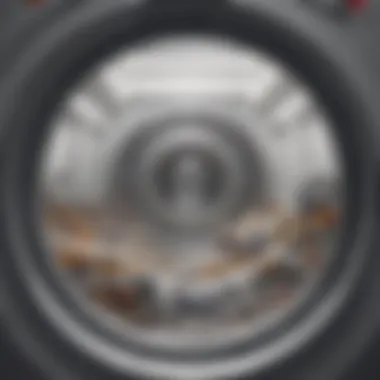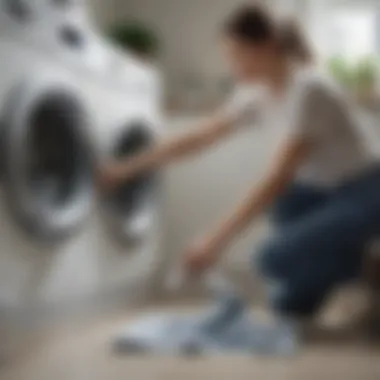Ultimate Guide to Cleaning Your Washing Machine


Intro
Cleaning and disinfecting a washing machine is often overlooked. Many individuals assume that as long as the machine is running well, there is no need for cleaning. However, this approach can lead to a buildup of dirt and bacteria, affecting the cleanliness of your laundry and the efficiency of the machine. Understanding the importance of this process is essential for maintaining a hygienic home environment.
In this guide, you will find comprehensive steps detailing how to effectively clean and disinfect your washing machine. The article will cover types of contaminants that can accumulate over time, suitable tools and products for cleaning, and preventive measures to prolong the lifespan of the machine.
Taking the time to properly maintain your washing machine not only enhances its performance but also contributes to household hygiene, making it a crucial practice for any conscientious homeowner.
By following this guide, you will ensure a cleaner, more efficient washing machine.
Understanding the Importance of Cleaning
Cleaning a washing machine might seem trivial at first glance, yet it plays a crucial role in maintaining both the appliance and the quality of laundry. Often, washing machines become breeding grounds for various contaminants if not properly maintained. This section aims to highlight why cleaning should not be overlooked and its broader implications on laundry performance and hygiene.
Why Regular Cleaning is Necessary
Regular cleaning of a washing machine is vital to ensure optimal performance. Over time, residual detergent, softeners, and other substances can accumulate, creating a residue. This buildup not only affects the machine's efficiency but can also lead to unpleasant odors.
Moreover, modern washing machines operate at lower temperatures, making them more susceptible to microbial growth. Therefore, routine cleaning helps mitigate this risk. Beyond aesthetics, what is truly at stake is the functionality of what is arguably one of the most used appliances in any household. An unclean machine can cause operational issues, leading to costly repairs or replacements.
Impact on Laundry Quality
The quality of laundry is directly affected by the cleanliness of the washing machine. If a machine is dirty, clothes washed in it may come out smelling musty or looking dull. Residue from previous loads can transfer to new ones, compromising their freshness. This is particularly crucial when washing sensitive fabrics or items like bed linens and towels that rely heavily on cleanliness.
In addition, channeling contaminants to laundry can pose health risks. Bacteria, mold, and other allergens may remain on fabrics, leading to skin irritations or allergic reactions. Therefore, ensuring that the washing machine is regularly cleaned contributes to cleaner, safer laundry, enhancing both the appearance and longevity of garments.
Regular maintenance of your washing machine not only preserves its functionality but also ensures the hygiene of your laundry, making it a necessary practice for any household.
In summary, understanding the importance of cleaning your washing machine establishes a foundation for better laundry results. By avoiding buildup and promoting cleanliness, you can maintain a more efficient machine while ensuring your clothing remains fresh and hygienic.
Identifying Common Contaminants
Cleaning your washing machine is essential, but it is crucial to first understand what kind of contaminants may be lurking inside. This section discusses common issues like mold, detergent residue, and harmful bacteria. Recognizing these elements can help in developing effective cleaning strategies.
Mold and Mildew
Mold and mildew can flourish in damp environments, keeping your washing machine in its neglected state can lead to these unwanted guests. The main areas prone to mold growth include the rubber door seal and the detergent drawer. Mold thrives in moisture, making the presence of remnants from previous washes an ideal breeding ground. Mold not only produces unpleasant odors but can also transfer to your laundry, potentially compromising its cleanliness.
Regularly inspecting the seals and the machine's interior reduction can minimize the risk of mold. A quick wipe down after each use will go a long way in preventing mold and mildew growth.
Detergent Residue
Detergents are essential for cleaning clothes, but they can also cause issues if not handled properly. Over time, detergent can build up inside the washing machine, especially in the detergent drawer and dispenser. This residue can trap dirt and other contaminants, complicating the cleaning process. It may also create a breeding ground for bacteria.
Using the correct amount of detergent for your specific load is crucial. Too much detergent can lead to buildup, while too little may not clean effectively. Using high-efficiency detergents in standard machines can exacerbate the problem as well. Regularly cleaning the detergent drawer can help in avoiding any unwanted residue buildup during laundry cycles.
Bacteria and Germs
Bacteria and germs can hide in various components of the washing machine. The wet and warm environment of a washing machine creates the perfect conditions for bacteria to thrive.


Common locations that can harbor these germs include:
- Door seals
- Detergent drawers
- Internal drum
Laundry that includes highly contaminated items, such as gym clothes or soiled linens, carries a risk of transferring bacteria throughout the machine. To mitigate these risks, consider conducting regular disinfections with suitable cleaning agents. An effective routine not only ensures cleaner laundry results but also promotes overall home hygiene.
Maintaining an awareness of these common contaminants can guide you toward more effective cleaning strategies, enhancing the performance and longevity of your washing machine.
Tools and Supplies Required
Cleaning and disinfecting a washing machine is not effective without the appropriate tools and supplies. Using the right cleaning agents and equipment enhances the overall cleanliness and hygiene of the appliance. It also ensures that the process is efficient and that users can achieve desirable results. Understanding what tools and supplies are necessary is essential to prevent any potential damage to the washing machine and ensure thorough cleaning.
Cleaning Agents
Vinegar
Vinegar is a popular natural cleaning agent due to its versatility in deodorizing and cutting through grime. It has acetic acid, which helps to dissolve mineral deposits and remove odors. Using vinegar in the cleaning process of a washing machine can effectively eliminate mold and mildew. Its non-toxic nature makes it a safe option. However, its strong odor can be off-putting for some users.
Baking Soda
Baking soda is known for its deodorizing properties and gentle abrasive quality, making it ideal for loosening dirt and residues. It can enhance the cleaning power of vinegar when used in combination. This means that using baking soda not only helps to absorb unwanted smells but also aids in managing tough stains. It is important to note that while baking soda is very effective, it may not be as efficient as stronger chemical cleaners for heavy-duty cleaning.
Bleach
Bleach serves as a powerful disinfectant, killing various bacteria and germs effectively. Its chlorine content makes it a strong option for ensuring a hygienic washing machine. Using bleach can prevent mold growth and eliminate stubborn stains. Nonetheless, bleach must be used with caution, as it can discolor fabrics if accidentally mixed during laundry cycles. This chemical cleaner also has strong fumes that may require good ventilation during use.
Commercial Cleaners
Commercial cleaners are specifically designed for cleaning washing machines and often provide detailed instructions on usage. These products usually contain a mix of surfactants and other active ingredients to tackle various types of build-up. Their effectiveness can be appealing for those looking for a straightforward solution. However, some users may prefer more environmentally friendly options and be wary of unknown chemicals in commercial products.
Tools Needed
Microfiber Cloths
Microfiber cloths are preferred for cleaning surfaces inside the washing machine. These cloths trap dirt effectively and do not scratch surfaces. They are also washable and reusable, making them a sustainable choice for cleaning practices. The ability to capture particles without leaving lint is a key characteristic that, overall, enhances the cleaning experience. Yet, not all microfiber cloths are durable, so choosing quality products is crucial.
Scrub Brushes
Scrub brushes come in various sizes and shapes, allowing users to reach different parts of the washing machine, including crevices. A firm-bristled brush is particularly effective for scrubbing away caked-on residues. Choosing a brush with softer bristles is ideal for sensitive areas, preventing damage to the machine during the cleaning process. However, some brushes may not endure heavy use and could require replacement sooner than expected.
Sponges
Sponges are regular cleaning supplies that can be used to apply cleaning solutions effectively. They offer a soft scrubbing surface for easy cleaning and absorption. Usually, sponges are inexpensive and easily accessible. Their main limitation lies in their longevity, as they may harbor bacteria if not properly cleaned after use.
Step-by-Step Cleaning Process
The step-by-step cleaning process is crucial for maintaining the performance and longevity of your washing machine. This systematic approach ensures that each component receives the attention it needs, which can improve hygiene and efficiency. Regular cleaning can prevent unpleasant odors, reduce malfunction risks, and enhance the overall washing quality. Below are detailed steps that guide you through effective cleaning practices.
Preparing the Washing Machine
Before diving into the cleaning process, it is vital to prepare your washing machine. Start by unplugging the appliance. This step is crucial for safety, as working on an active machine can lead to electrical hazards. Remove any clothing or items from the drum. It’s important to ensure that the machine is empty. This allows you to access every section without obstruction. Next, gather your cleaning supplies, including microfiber cloths, scrub brushes, and the appropriate cleaning agents. You want to have everything ready to make the process efficient.


Cleaning the Drum
After preparation, proceed to clean the drum. For this, you can make use of a solution made from vinegar or baking soda. Pour about two cups of vinegar into the drum and run a hot water cycle. This action helps tackle any odors and remove build-up. If you prefer baking soda, you can add half a cup during a similar hot cycle. Make sure to look for any signs of rust or damage while cleaning. If you notice anything unusual, consider calling a professional for further inspection.
Disinfecting the Door Seal
The door seal is often overlooked but can be a breeding ground for mold and bacteria. To clean it effectively, use a mixture of vinegar and water. Dip a microfiber cloth in the solution and wipe down the seal thoroughly. Pay special attention to the folds and crevices, as these areas tend to trap dirt and moisture. After wiping, use a dry cloth to ensure it is completely dry. A dry seal minimizes the risk of mold growth.
Cleaning the Detergent Drawer
Cleaning the detergent drawer is another important step in the process. Remove the drawer from the washing machine. Soak it in warm, soapy water for at least 15 minutes. This helps loosen any buildup. After soaking, scrub it with a soft brush. Ensure that all detergent residues are removed, as these can clog the compartments and affect performance. Rinse the drawer thoroughly and let it dry completely before reinserting it back into the machine.
Clearing the Filter
Finally, don’t forget to clear the filter. This step is essential to prevent lint and debris from accumulating. Locate the filter, usually found at the front of the machine, and open it carefully. Remove any visible debris and rinse it under running water. Depending on the model, you may also need to remove the filter from the housing unit to clean thoroughly. Always refer to the manufacturer’s manual for specific instructions on handling the filter. After cleaning, replace the filter securely.
Regular maintenance of your washing machine not only enhances cleaning efficiency but also prolongs appliance life.
By following these steps, you ensure that your washing machine operates at optimal performance. Regular cleaning pays off with fresher laundry and fewer mechanical issues. Attention to detail in each of these tasks is vital. Only through diligent cleanup can you avert common problems associated with washing machines.
Alternative Methods
Alternative methods for cleaning and disinfecting washing machines can provide effective solutions without the use of harsh chemicals. Understanding these methods can broaden your cleaning options and help in maintaining the longevity of your appliance. They not only reduce the potential for chemical residue on your clothing but also promote a more environmentally friendly approach to cleaning. Utilizing natural cleaners and the appliance's self-clean feature can combat the buildup of grime effectively. It is important to weigh the benefits and limitations of each approach as you consider the best cleaning strategy for your washing machine.
Using Natural Cleaners
Natural cleaners represent a safe and eco-friendly alternative to chemical-based solutions. Common ingredients such as vinegar and baking soda can work together to eliminate odors and sanitize surfaces.
- Vinegar: This ingredient is effective against mold and mildew. Its acetic acid content can break down mineral deposits, which are often found in hard water areas. To use, add two cups of white vinegar to the empty drum and run a hot wash cycle. This method not only deodorizes but also leaves surfaces free of grime.
- Baking Soda: Known for its deodorizing properties, baking soda can be particularly useful in removing stubborn smells. Mix a cup of baking soda with water to create a paste. Apply this mixture to any problematic areas, then scrub lightly with a brush before running a rinse cycle.
- Combination of Both: Mixing baking soda and vinegar can enhance cleaning power. Start by adding the baking soda and then the vinegar. The reaction creates a foam that helps lift dirt within the machine.
Natural cleaners are not only cost-effective but also minimize chemical exposure for individuals with sensitivities. However, it is crucial to perform these cleaning methods regularly to maintain optimal results.
Appliance Self-Clean Feature
Many modern washing machines come equipped with a self-clean feature, serving as a practical solution for maintenance. This function typically allows the machine to clean itself without requiring additional manual effort.
- Functionality: During the self-clean cycle, the appliance uses heat and water to eliminate bacteria, mold, and detergent residue. To initiate this cycle, refer to your user manual for specific instructions related to your model. Usually, it involves emptying the drum, adding a specialized cleaning agent, and pressing the appropriate buttons.
- Benefits: By utilizing the self-clean feature, you can save time and ensure a consistent cleaning. This automated process can often reach areas that are difficult to clean manually. Moreover, it helps maintain efficiency by preventing clogs or buildup that may impair function over time.
- Considerations: While the self-cleaning feature is convenient, it should not replace regular manual cleaning practices. It is still important to check door seals, detergent drawers, and filters regularly, as these parts may require hands-on attention.
The self-clean feature offers an easy maintenance solution, but understanding how it works will ensure it is optimized effectively for your washing machine's needs.
Keep in mind that regular use of both natural cleaners and the self-clean feature can vastly improve the hygiene and performance of your washing machine. Consistency in these practices only leads to better laundry experiences.
Preventive Maintenance Tips
Preventive maintenance for a washing machine is crucial for enhancing its lifespan and efficacy. By regularly tending to your appliance, you can prevent common issues such as mold growth, detergent buildup, and performance degradation. This section will address a few key strategies for maintaining your washing machine that can ultimately translate into cleaner clothes and fewer repairs.
Routine Cleaning Schedule
Establishing a routine cleaning schedule is essential for the proper upkeep of your washing machine. Aim to clean your machine at least once a month, but this can vary based on usage. If you do a large volume of laundry or have hard water, consider cleaning it bi-weekly.


Key points include:
- Monthly deep clean: Use vinegar, baking soda, or a commercial washing machine cleaner.
- Regular checks: Look for any signs of mildew or residue each week.
- Note on water temperature: Setting your washing machine to run warm cycles occasionally can help dissolve residue effectively.
Adhering to a cleaning schedule not only maintains hygiene but also supports the performance of your washing machine for years to come.
Proper Loading Techniques
Correct loading techniques are vital for maximizing the efficiency of your washing machine. Overloading can lead to inadequate cleaning and increased wear on components. Here's what to consider:
- Load Size: Ideally, a washing machine should be filled no more than two-thirds of its capacity. This allows water and detergent to circulate freely.
- Even Distribution: Make sure to distribute items evenly. This prevents unbalanced loads that can damage the machine.
- Item Type: Different fabrics need different care. Avoid mixing heavy items like towels with lighter fabrics.
Following these techniques will not only ensure cleaner clothes but also extend the life of the appliance.
Ventilation Considerations
Proper ventilation is often overlooked but vital to the maintenance of your washing machine. It helps prevent mold and odor from developing. Here are some tips on how to ensure good ventilation:
- Leave the door open: After each wash, leave the door ajar to allow moisture to escape.
- Check surroundings: Ensure the area around the washing machine is well-ventilated. Avoid placing it in a sealed closet or without sufficient airflow.
- Clean the lint trap: If your appliance has a lint filter, clean it regularly to ensure airflow is not obstructed.
By addressing ventilation, you can prevent moisture buildup that leads to mold growth and unpleasant odors, further enhancing the hygiene of your laundry experiences.
Important Reminder: Regular preventive maintenance is key to preserving the functionality and cleanliness of your washing machine.
Impact of Different Washing Machine Types
Understanding the variations in washing machine designs is crucial when it comes to cleaning and disinfecting them. The type of machine — whether top-loading, front-loading, or compact and portable — influences not only how contaminants accumulate but also how they should be approached in terms of maintenance. Adapting cleaning methods to suit each model allows for a more effective removal of dirt, detergent residue, and unpleasant odors.
Top-Loading vs. Front-Loading Machines
Top-loading washing machines typically have a larger capacity. They allow for easier access, making it simpler to inspect and clean inner components. However, these machines can be prone to detergent buildup in areas like the lid and around the agitator. Regular cleaning is important to avoid mold growth and maintain laundry quality.
Front-loading machines, on the other hand, are more energy-efficient and use less water. They require more attention to the door seal and detergent drawer, as these areas can quickly accumulate moisture and residue, promoting mold and mildew growth. It's critical to follow a strict cleaning protocol tailored to these unique aspects.
"Different washing machine types require distinct cleaning methods, considering their design and potential issues."
Compact and Portable Models
Compact and portable washing machines are designed for small spaces. They do not always offer the same features as larger models, like rinse cycles or advanced rinse options. Therefore, routine cleaning in these models may involve a more hands-on approach. Given their smaller size, clearing the lint filter and cleaning the drum often is essential. Even though they are easier to manage, neglecting these factors can cause quick functionality issues.
Closure
Cleaning and disinfecting a washing machine is not just a routine chore; it is essential for maintaining the appliance’s efficiency and ensuring hygienic laundry results. Throughout this article, we have explored various elements that underline the importance of this task.
Recap of Key Points
- Regular cleaning prevents mold, mildew, and bacteria buildup, which can contaminate laundry.
- Identifying common contaminants and knowing how to eliminate them enhance the quality of the laundry.
- Employing the right tools and cleaning agents is crucial for effective maintenance.
- Alternative cleaning methods can be utilized, such as natural cleaners or self-clean features.
- Preventive maintenance tips, like proper loading and a routine cleaning schedule, significantly improve the washing machine’s lifespan.
Revisiting these points underscores how a clean washing machine contributes to a healthier home.
Encouragement for Regular Maintenance
Consistently maintaining your washing machine is beneficial for both the appliance and the quality of your laundry. By establishing a cleaning schedule, you can avoid potential issues that arise from neglect. Simple practices, like ensuring a dry drum after each wash and periodically wiping down surfaces, make a significant difference in performance.
Furthermore, keeping an eye on the detergent drawer and cleaning the door seal often prevents residue buildup. A proactive approach not only enhances the efficiency of your washing machine but also extends its operational life. Remember, an ounce of prevention truly does go a long way.
By taking these measures, you can enjoy laundry that is not only clean but also free from unwanted odors and contaminants. Regular maintenance is an investment in your appliance’s future—making the effort worthwhile.







